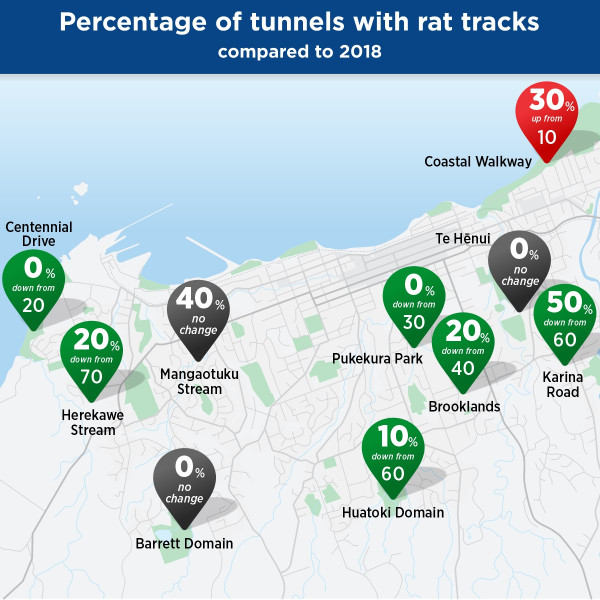Rat numbers in New Plymouth continue to trend downwards, with a slight year-on-year increase coming as no surprise to experts.
Each April since 2018 Towards Predator-Free Taranaki has monitored rodents at 10 sites across New Plymouth city. At each site 10 tracking tunnels are baited with peanut butter and left out for one fine night. In the morning, prints in the ink reveal whether there were rats, mice or other creatures present.
This year rats were detected at 17% of tracking tunnels, up from a record low 9.8% last year. It is still significantly less than the 33% in 2018, when Taranaki Regional Council launched the Towards Predator-Free Taranaki programme(external link).
Programme lead Sam Haultain says this year’s result was no great surprise to her team or regional council scientists.
“We’ve had amazing weather over the last year or two, which rodents love. They have plenty of food and it has been warm, so last year was always going to be hard to beat! Keeping the rate at 17% is testament to the community’s awesome trapping effort and just motivates us to keep on going.
“The good news is just one of the 10 sites tracked higher this year than at the start of the programme, with six lower and three showing no change.”

Ms Haultain says Towards Predator-Free Taranaki and New Plymouth District Council (NPDC) will use the monitoring results to target problem areas. They will also learn from and build on the positive gains made at a number of public areas across the city.
These include the sites at Herekawe Stream, Centennial Park, Huatoki Domain, Brooklands, Pukekura Park and Karina Rd, where there are active volunteers looking after trapping networks.
On the flipside, the Coastal Walkway site near Bell Block has gone from a 10% to 30% tracking rate since 2018. With so many people using the walkway, there is plenty of food available for rats. This bolsters their population and reduces the effectiveness of traps.
“There are traps along the walkway and we are working with NPDC to improve their efficiency, given the availability of other food resources.
“A lot of wildlife lives in and around this area, including the precious kororā/little blue penguin, which makes this even more important.”
In urban areas, Towards Predator-Free Taranaki has to date focused on rats, as they do the most damage to native birds, lizards and biodiversity and are a target species for the Predator Free 2050 goal. More than one in five New Plymouth households have a rat trap in their backyard and NPDC maintain trapping networks throughout public parks and walkways.
The urban team has widened its focus to include possums, destructive predators that are known to live in New Plymouth and other towns. Subsidised, humane traps are available for those who wish to set and maintain them in their backyards.
For information about volunteering or trapping contact pftaranaki@trc.govt.nz or follow Towards Predator-Free Taranaki(external link)(external link) on Facebook.